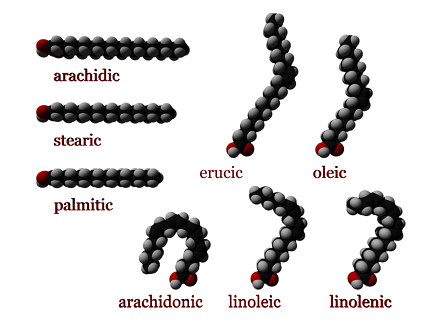Last Updated: 18 September 2022

Figure 1. Three-dimensional representations of several fatty acids. Saturated fatty acids have perfectly straight chain structure. Unsaturated ones are typically bent, unless they have a trans configuration.
In biochemistry, a Fatty Acid is a carboxylic acid with an aliphatic (or hydrocarbon) chain which can be either saturated or unsaturated (i.e. whether their molecular structure contains a carbon double bond or not). Saturated Fatty Acids do not have any carbon double bonds; whereas unsaturated Fatty Acids have at least one carbon double bond or more.
Examples of saturated Fatty Acids:
Examples of unsaturated Fatty Acids:
Aside from being saturated or unsaturated, Fatty Acids can also be classified according to their molecular length.
Fatty Acids are both important dietary sources of fuel for animals and important structural components for cells. In animals, Fatty Acids are formed from carbohydrates predominantly in the liver, adipose tissue, and the mammary glands during lactation.
Fatty Acids are insoluble in water. They can only be broken down in mitochondria (i.e. the "power generator" within cells) via beta oxidation and subsequently, reactions with oxygen, which generates a lot of energy for cells (ATP). However, cells in the central nervous system cannot absorb free Fatty Acids from blood, as the blood-brain barrier is impervious to most free Fatty Acids. Cells in the central nervous system have to manufacture their own Fatty Acids from carbohydrates in order to produce and maintain the phospholipids of their cell membranes and those of their organelles.
Essential Fatty Acids are Fatty Acids that are required for good health but cannot be made in sufficient quantity within the human body. Two essential Fatty Acids in the human body are Linoleic Acid and alpha-Linoleic Acid (ALA). These Fatty Acids are widely provided by plant oils. The human body has limited ability to convert ALA into Eicosapentaenoic acid (EPA) and Docosahexaenoic acid (DHA), which form the primary structural component of the human brain, cerebral cortex, skin, and retina. Essential Fatty Acids must be supplemented through dietary intake.
Sources and Citations:
* Please be advised: always seek medical consultation if you require medical help or attention. The contents of this Codex are for educational purposes and are not intended to offer personal medical advice.